Article at-a-glance: - All the major ecom brands like Amazon, eBay, Walmart, etc. get the bulk of their referral traffic from Google, more than social media, paid ads, or any other traffic source. - Google is the premier source of high-quality, targeted traffic for ecommerce businesses. - The traffic on Google is more valuable than other platforms because users are actively searching for specific products and services. - Despite the presence of other platforms like Facebook, Twitter, and YouTube, Google remains the dominant player in the traffic game. - As evidenced by top players in various industries prioritizing Google traffic, successful businesses recognize Google's value in driving profits and elevating brand reputation.
With a track record of driving millions in online sales for 100s of e-commerce businesses, I’ve come to recognize Google as the most powerful yet massively overlooked source of e-commerce traffic.
Backed by substantial evidence from industry leaders in the space and the fundamental principles of online traffic and conversions, the impact of organic Google traffic extends beyond boosting sales to enhancing brand reputation, business value, and conversion rates across all traffic channels.
Think of it as premium octane fuel for your business, where 10 clicks from Google surpass the value of a truckload from Instagram and Facebook, given the targeted intent of Google users.
While platforms like Facebook, Twitter, and YouTube have their merits, this article will reveal why Google’s search traffic is the holy grail for e-commerce success and why ignoring it is a missed opportunity.
Google Traffic Is The Lifeblood of Businesses
Businesses need traffic to grow and Google is the best sorce of traffic online… here is why…

Businesses need traffic to grow. Think of it as a crowd of people flooding into your shop or website. Here’s what I mean:
- Increased visibility in Google = stronger brand: Think about it – more traffic means more eyes on your business. You’re basically putting up a neon sign that says, “Hey world, check us out!” This gives people more chance of discovering your products or services.
- Conversion Increases as people research & see positive results: Simple math – more traffic, more conversions! It’s like having more people walk into your store – the more they explore, the more likely they are to buy.
- Search Engine Rankings drive more traffic (and boost brand reputation): Search engines, especially Google, are like modern-day treasure maps. Guess what? They love traffic. When you have a lot of visitors, Google takes notice and thinks, “Hey, these folks must be on to something!” That’s like getting a VIP pass to higher search rankings.
- Best source of traffic = more sales: It’s like having a constant stream of potential customers knock on your door. More people means more sales, more money, and more profits.
Traffic is the jet fuel that rockets your business into the spotlight, driving revenue and sparking conversations about about your offerings.
What is The Number 1 Website In The World?
According to various sources, including SimilarWeb, Semrush, and Visual Capitalist, Google is the most visited website in the world. Other popular websites include YouTube, Facebook, Twitter, and Wikipedia.
Would you like to know which website is currently number one in the world? A drumroll please… You’re right, it’s Google!
Similarweb.com, semrush.com, and visualcapitalist.com all acknowledge Google. With a massive 8.5 billion searches per day, it’s clear why Google reigns supreme as the most popular search engine worldwide.
With such a vast audience, ecommerce businesses have an opportunity to reach countless potential customers through Google.
Google traffic is a win for almost any type of business.
- Website owners, bloggers, affiliates
- Agencies and consultant
- Ecommerce businesses
- Expats and coaches
- Local business
The Most Valuable, Profitable, And Highest-Converting Traffic Ever Comes From Google.
Google has more traffic than Facebook & Youtube combined!
The number of people using these platforms continues to rise every year, and it looks like they’re not going to slow down anytime soon!
Not convinced, let’s look at the biggest source of traffic of the top eCom brands…
What Is Amazon’s Biggest Source of Traffic?
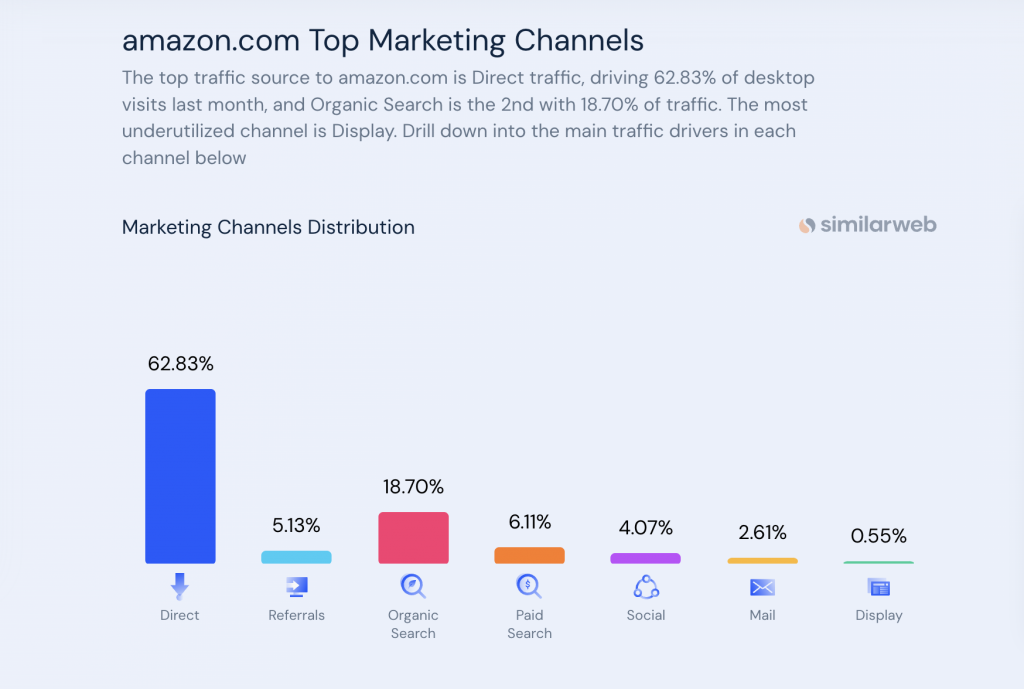
So you wanna know where Amazon gets the most traffic? Here’s how it works:
A significant 62.83% of users visit Amazon directly, underscoring the strength of their brand loyalty. However, when considering external traffic sources, Google’s organic search stands out as the predominant contributor with 18.70%.
While this statistic shows that a significant portion of Amazon’s visitors search on Google before landing on its platform, in essence, Google drives most of Amazon’s traffic, making it its most important visitor source.
You might be thinking Amzon is spending more money on ads but no – paid search which also includes Google ads, also drives significantly less traffic.
But is Amazon a fluke because it’s the biggest ecom brand in the world? What about everyone else?
What Is Ebay’s Biggest Source of Traffic?
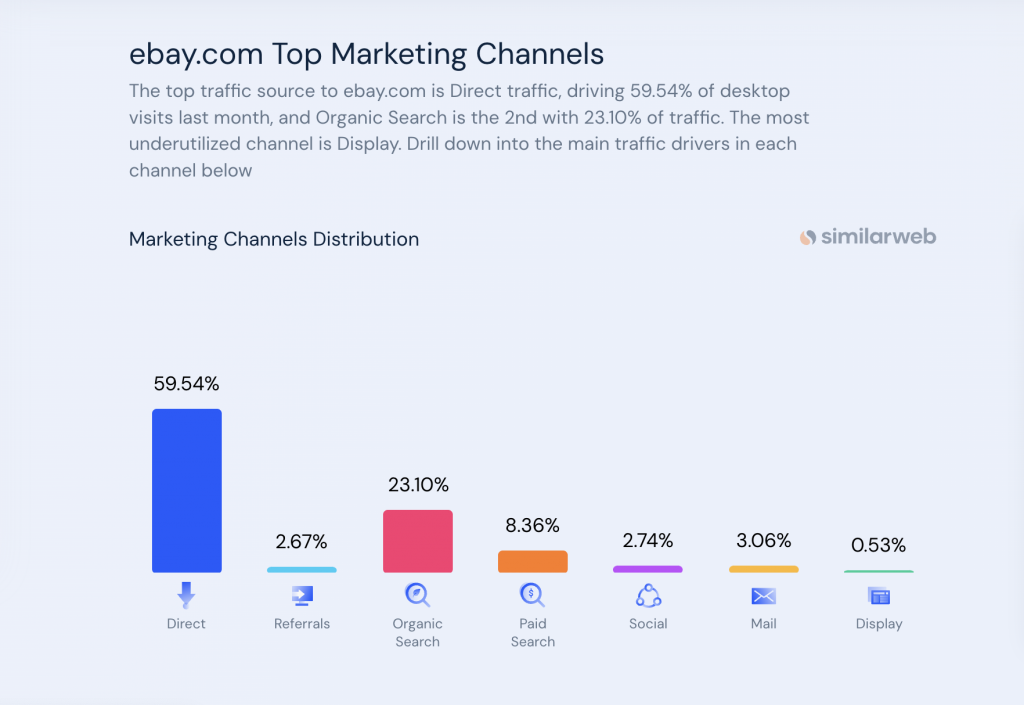
Wondering where most of eBay’s visitors come from? Well, let’s break it down real quick:
Google is the most dominant traffic source for eBay. The strong brand presence of eBay is evident in the large percentage of all users who navigate directly to eBay.
Despite Amazon being the larger brand, it’s interesting to note that the smaller brand, eBay, actually receives between 23.10% to 44.03% of its traffic from Google’s organic search. This shows that eBay relies even more heavily on Google for its audience reach than Amazon.
Through its search engine, Google directs a substantial audience to eBay.
There are also referral sources supporting eBay, but the undeniable influence of Google’s search results makes it its primary traffic source. And compared to social media traffic, organic traffic from Google is ridiculously high.
Note that these numbers may slightly fluctuate based on regional differences and ad campaigns but Google still emerges as the most dominant source.
What Is Walmart’s Biggest Source of Traffic?
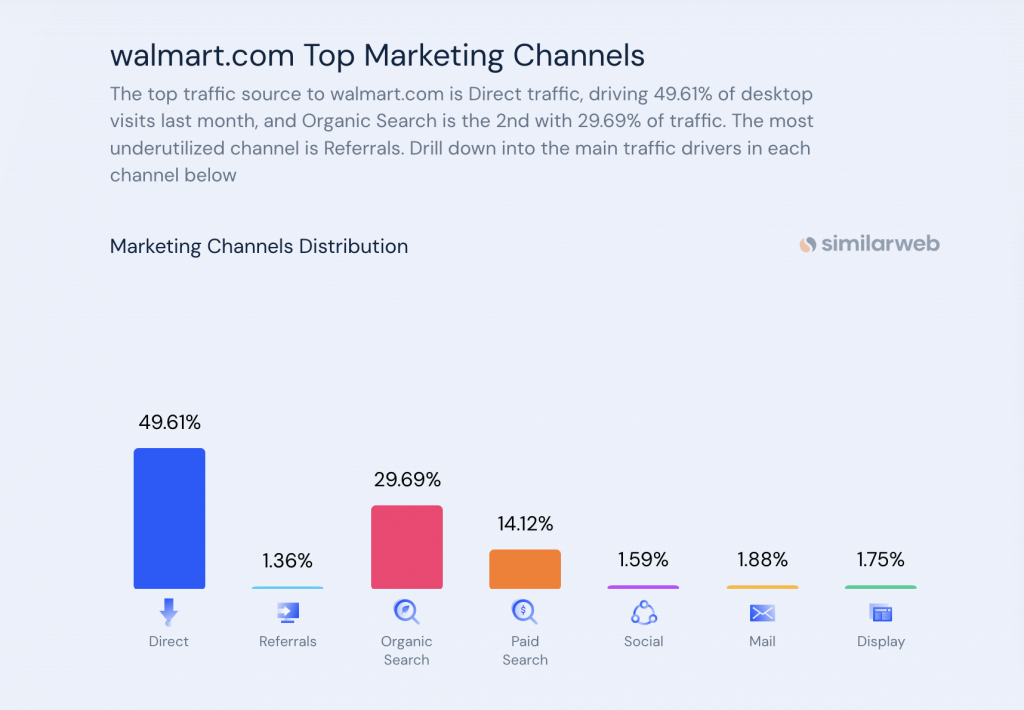
When it comes to driving traffic to Walmart’s online platform, Google wins hands down. Walmart’s strong brand recognition and customer loyalty are evident in 49.61% of visitors last month typing “walmart.com” directly into their browsers.
Search engines like Google contribute significantly to Walmart’s online traffic, accounting for about 29.69% of its visitors.
However, Walmart’s traffic sources are not dominated by social media, which is often overemphasized by marketers.
Despite Walmart’s presence on platforms like YouTube, Reddit, and Facebook, these social channels generate only a fraction of their overall traffic. YouTube accounts for 29.62%, while Reddit and Facebook contribute 15.69% and 13.84%, respectively.
These figures highlight that while social media has its place in Walmart’s marketing strategy, it remains a minor player compared to the colossal influence of Google and direct traffic.
Google Is Still #1: Top traffic source in EVERY ecom niche studied!
A recent study involving 3.25 billion website visits confirms Google’s unquestionable dominance as the primary traffic source across numerous industries, generating more than 50% of all web traffic, which is eight times greater than the collective impact of social networks combined.

In another study, the breakdown of traffic sources across 12 niches clearly shows Google’s dominance as a primary traffic source, accounting for 60.68% of all web traffic.
In contrast, direct traffic dominates social media, accounting for 27.49%, compared with social media’s modest 6.44%, confirming the importance and reliability of the search engine Google.

The graph’s breakdown of traffic sources across 12 niches underscores Google’s unparalleled dominance as the primary traffic source.
This data resonates powerfully with the e-commerce realm, where approximately 43% of traffic is attributed to organic Google searches.
This illustrates the immense potential in optimizing your e-commerce site for Google, harnessing substantial, targeted, and cost-free traffic.
Furthermore, the steadfast reliability of organic Google traffic remains immune to fluctuations in ad platforms, algorithm shifts, or fleeting trends, offering businesses a robust and enduring source of potential customers.
When your e-commerce brand is able to consistently generate organic traffic from Google, it contributes to a stable and reliable source of potential customers.
Regardless of niche, Google remains the top traffic source for ecommerce websites.
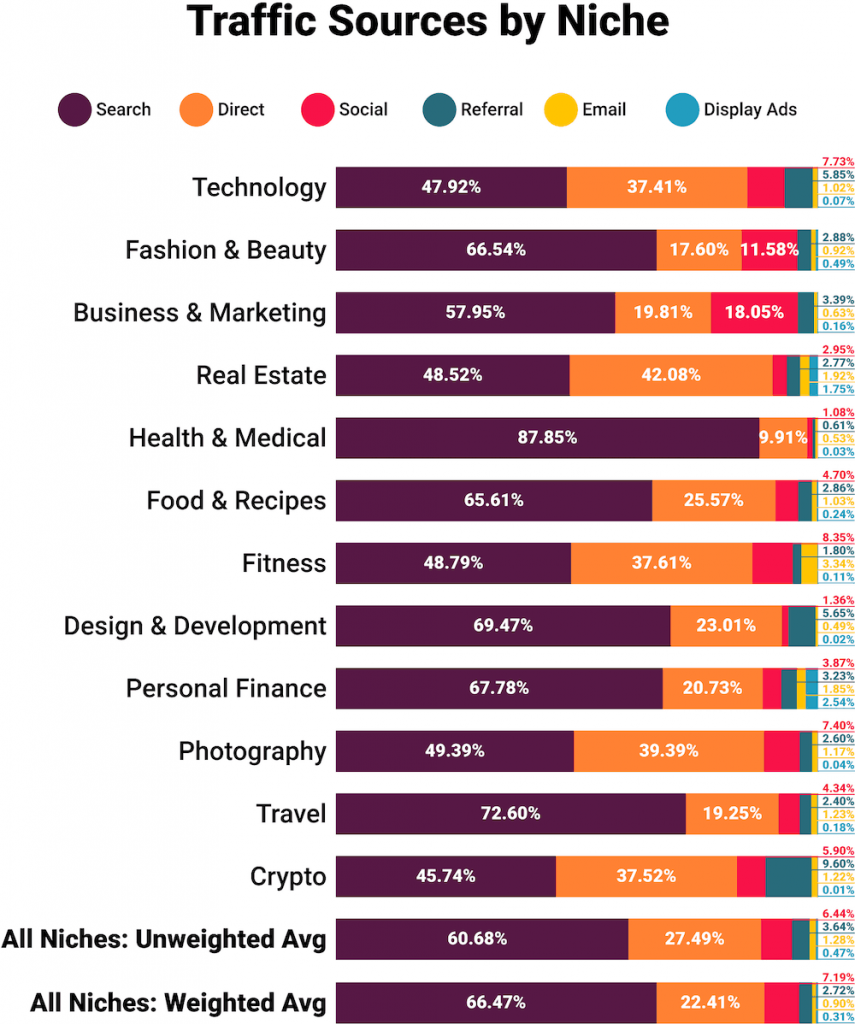
In most industries, Google is the most important traffic driver followed by Facebook. In niche sectors like Design and Development, YouTube is the second most influential traffic source, while in the Crypto niche, Twitter is the second most important traffic source behind Google.
Health and Medical is the most dependent on Google at 87.85%, indicating its critical role in driving traffic to healthcare-related websites. Crypto is the least dependent on Google at 45.74 percent, indicating greater diversity of traffic sources.
Additionally, Facebook contributes only 13.52% of traffic to Business and Marketing, while Google takes 57.95%, underscoring Google’s importance. Similarly, in the Fashion and Beauty niches, Facebook plays a secondary role with 17.60% of traffic, while Google dominates with 66.54%.
Even in niches where Direct traffic is prevalent, like Real Estate, Google continues to dominate with 48.52% of traffic, outpacing Direct traffic at 42.08%.
Across all niches studied, Google consistently accounts for approximately 66.47% of traffic, overshadowing Facebook’s 22.41%. Instagram contributes less than 1% of traffic in every niche, regardless of the niche.
As you can see, a wide range of statistics point to Google’s unrivalled position as a top source of traffic.
Why Social Media Traffic Falls Short:
Social media, while a powerful platform, has several limitations when it comes to driving effective traffic for businesses.
- Untargeted, focused on entertainment
- Very low conversion rates
- Interruptive, not demand-driven
- Less overall traffic
- Penalization of outbound links by social media algorithms, reducing exposure for promotions
Businesses Spend More on Google. Why? Because It Makes The Most Money!
The numbers don’t lie – businesses allocate substantial budgets to Google because it’s proven money-making machine. Google is the go-to platform for advertising due to its exceptional profitability and unparalleled traffic quality.

Amazon Spends hundreds of millions on Search Engine Marketing:
E-commerce giant Amazon invests hundreds of millions in Search Engine Marketing. It’s clear that smaller e-commerce businesses should follow Amazon’s lead if Amazon prioritizes organic traffic growth.
This is essential for any e-commerce business because organic traffic offers higher profit margins than paid advertising, contributing to long-term sustainability. Additionally, it establishes brand credibility and trust, which attracts and retains customers who are increasingly discerning. Besides, organic traffic reduces businesses’ reliance on costly advertising budgets, resulting in a more cost-effective e-commerce strategy in the long run.
But why Google? Well, it’s not just any website; it’s the world’s most visited one, making it an unbeatable advertising powerhouse.
As the largest online marketplace, Amazon is second to Google in terms of advertising saturation during the holidays.
For sales and engagement, small businesses may use Facebook, Instagram, LinkedIn, TikTok, and Twitter, but it’s Google that’s the preferred destination, as demonstrated by a wide spectrum of annual web-related expenditures, ranging from $500 to $15,000,000—a testament to its unrivaled popularity.
In a study conducted back in 2022, certain digital giants emerged as dominant players in the advertising scene.
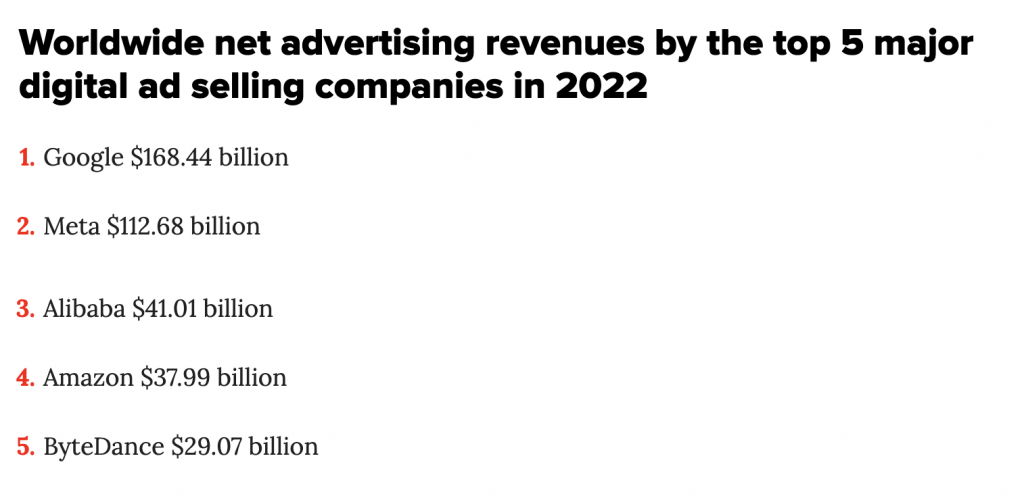
Google took the top spot with a jaw-dropping $168.44 billion in ad revenue.
Meta (Facebook) held its ground impressively, generating $112.68 billion, retaining its status as a formidable player.
In essence, the choice is clear: Google remains the ultimate destination for businesses looking to maximize profits through advertising.

Social Media Ads & YouTube Ads Are Great, But High Risk
Most people use Facebook ads because they’re easy to use and accessible. It’s not always true that popularity equals effectiveness. Facebook is easy to start with, but it doesn’t guarantee success, especially compared to Google. Here are some challenges advertisers might face.
Reasons why paid ads fail:
- Ad account shutdowns
- Algorithm changes
- Tracking and targeting challenges due to legal and technical updates (e.g., cookieless browsers, iOS updates affecting Facebook Ads users)
- Fierce bidding competition where the highest bidder prevails … whoever can pay the most wins… if you cannot, you can disappear
- Sudden revenue loss, creating a business vulnerability
- Paid ads without Google presence is throwing money away (details in the next section)
Depending solely on paid ads and volatile trends (often due to a FOMO) on other platforms can be risky.
It is well known that advertisers can get banned from Facebook Ads for a variety of reasons, resulting in an immediate loss of advertising investment.
And if you can’t pay the highest bid, your ads might not get the visibility you want, potentially costing you money. Let’s be honest: as more people get into online ads, things get crazy.
What is more, business can get hit by sudden changes in algorithms, ad account shutdowns, or other factors, resulting in lost revenue.
In addition, the digital advertising landscape is shifting toward cookieless ads, where privacy concerns and browser restrictions make traditional tracking less effective. It makes it harder to target and measure paid ads, so you might waste money.
Although Facebook Ads might work out for many businesses (and there are numerous success stories like Alex Fedotoff’s students ), when you rely heavily on platforms like Facebook, it’s like chasing short-term trends.
Businesses that don’t follow through will run out of steam (and cash).
A strategy like this can be short-sighted, just like following fashions that are hot now but will fade later. I always recommend a more stable long-term approach like organic traffic from Google.
Every single second, 90,460 people search Google, looking for solutions, checking out products, you name it. That’s a ton of opportunity! What’s more? Numbers like these are only going up.
With million dollars spent on Google and acing it in numerous markets, we can tell you snagging top-tier traffic is gold.
Don’t Run Paid Ads Without Optimizing Google Presence
I’ll give you a few real-world examples to demonstrate the importance of Google presence:

When running ads, having a strong Google presence is crucial. This is because consumers frequently research online before making a purchase; if your business doesn’t have a robust presence on Google, potential customers might distrust or overlook you.
By effectively targeting keywords and utilizing strategies like the ‘ampifire method’, brands can intercept and redirect traffic, essentially capitalizing on gaps left by others in the digital space.
- E-commerce Stores: In the world of e-commerce, Google is the starting point for many potential buyers. Research shows that consumers begin their shopping journey with a Google search 68% of the time.
Imagine you run an online clothing store. Without a robust Google presence, you risk missing out on the majority of shoppers looking for ‘stylish summer dresses’ or ‘men’s running shoes’. - Local Businesses: Google’s impact extends beyond online stores.
Consider a local restaurant or café. Search results for ‘best pizza near me’ or ‘cozy coffee shops’ on Google play a crucial role in driving foot traffic to your business. When you neglect your Google presence, you lose potential customers to your competitors. - Professional Services: Even in professional services, Google presence matters.
Whether you’re an accountant, lawyer, or marketing consultant, clients often look for experts online. By optimizing your Google presence and using content marketing, you can establish yourself as a trusted authority. - Product Information: Beyond shopping, people use Google to gather information.
A comprehensive product description on Google can educate and attract potential buyers in the tech industry. Buying decisions are often influenced by product reviews, specifications, and user experiences.
68% of Online Shoppers Begin with a Google Search
Google optimization is not an option; it’s a necessity for reaching and engaging your target audience. Without it, you risk missing out on valuable opportunities and customers who start their journey on Google.
The Massive Opportunity in Longtail Google Traffic
Digital marketing has a vast yet often overlooked opportunity: Longtail Google Traffic and Hyper-Targeted Content.
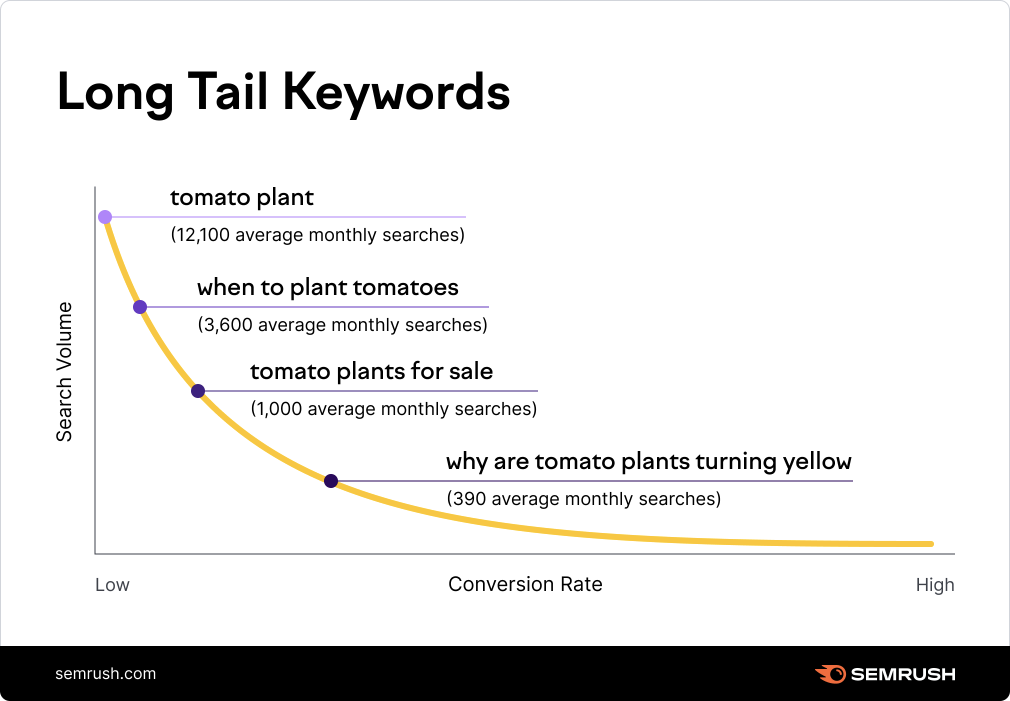
Longtail keywords have a higher conversion rate and lower cost per acquisition because they attract more specific and motivated searchers, resulting in a higher likelihood of conversion and less competition.
Longtail Google traffic is those specific and less competitive search queries people type in.
The use of longtail keywords like “organic bamboo baby onesies” rather than “baby clothes” allows businesses that specialize in sustainable baby clothing to reach a specific audience.
In spite of lower individual search volume, these queries represent a substantial and motivated audience, often ready to buy.
In order to take advantage of this potential, businesses need to craft hyper-targeted content that accurately addresses the needs, questions, and desires of users.
With longtail keywords and tailored content, companies can carve out a niche, stand out in a less crowded space, and unlock growth and success by satisfying the demands of this highly engaged audience.
Why Do Many Ecommerce Stores Ignore Google Over Social Media Ads?
Ecommerce stores tend to prioritize social media ads over Google because of misconceptions and short-term gains. Here are some of other reasons why this may be the case
- Social media’s popularity.
- Influencers draw attention and create the perception of greater business importance, despite conflicting facts.
- Google marketers often use confusing jargon, and some prioritize their own projects over collaborating with companies.
- Perceived inaccessibility to Google traffic, even though significant opportunities exist in niche topics (up to 6 levels deep), they don’t know where to start
- The process for acquiring Google traffic seems elusive and perplexing for many (but there’s a straightforward solution – see below).
- Most business owners focus on short-term gains and perceived wins from ads.
Short Term Thinking eCom Businesses

The biggest shift in perspective, the ultra-wealthy have versus the not wealthy is that they think in longer time horizons.
Google is a long term high value, high ROI play. Traffic is more stable, higher converting, increases business value, builds brand etc.
Most businesses want to run an ad, make money, but forget the long term implication.
Truly successful ecom businesses also invest in their Google presence, and as a result get higher conversions from their paid ads, open up high converting traffic, and make more sales.
The New Way to Get Google Traffic For Your Ecom Store
Running an e-commerce brand without tapping into Google for traffic is like leaving money on the table. Why? As we saw above, there’s no better source of buyer traffic than Google.
If your brand doesn’t show up on Google when people search for your products, your business might as well not exist.
It’s cool to run ads, mixing them with organic traffic is even better. Organic traffic gives you higher profit margins and adds credibility to your brand. It’s like the rock in your business: it makes your brand look legit.
You no longer need to wonder where to find the best e-commerce traffic. That’s Google.
The bottom line: Google’s where your audience is so make friends with Google and watch your e-commerce business thrive.
Need help? AmpiFire is the ultimate tool to supercharge your brand’s online visibility and drive Google traffic.
By strategically crafting ‘Boring Buyer Content’ and brand amplification, we ensure that your products and brand consistently appear in front of your target audience, leading to increased traffic and long-term business growth.
Want to tap into this valuable buyer traffic and boost your monthly customer base? Schedule a free call with one of our digital strategists to find out how.
Author
-
CEO and Co-Founder at AmpiFire. Book a call with the team by clicking the link below.
Related Posts
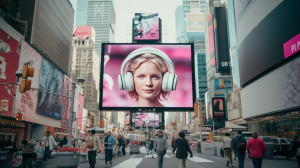
Podcast Ads & Sponsorship Benefits: Examples for Ecom Brands
In this guide, learn how to craft effective podcast ads and optimize content for enhanced ecom brand visibility with podcast…
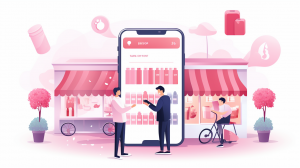
BigCommerce vs WooCommerce | eCom Platforms Pricing & Features Comparison
Dive into this comparison guide to learn the key features, integrations, and pricing between the two platforms BigCommerce and WooCommerce.

There’s No Such Thing As Bad Publicity: Why Brands Work Better When They Tell Their Own Stories
Negative press can be a good thing for your brand if you know how to handle it. So instead of…

How To Fix Your Online Reputation & Get A Second Chance With Google
Google is the most popular search engine on the planet, and for good reason. With over 8.5 billion searches every…

BigCommerce vs Shopify | eCom Platforms Pricing & Features Comparison
Learn the differences between BigCommerce vs. Shopify features and understand which E-commerce platform offers better value for your money.

How To Increase Your Google Maps Rankings with AmpiFire’s Citation Building Services?
Explore how AmpiFire's citation building services can enhance Google Maps rankings for local businesses and attract more customers.










